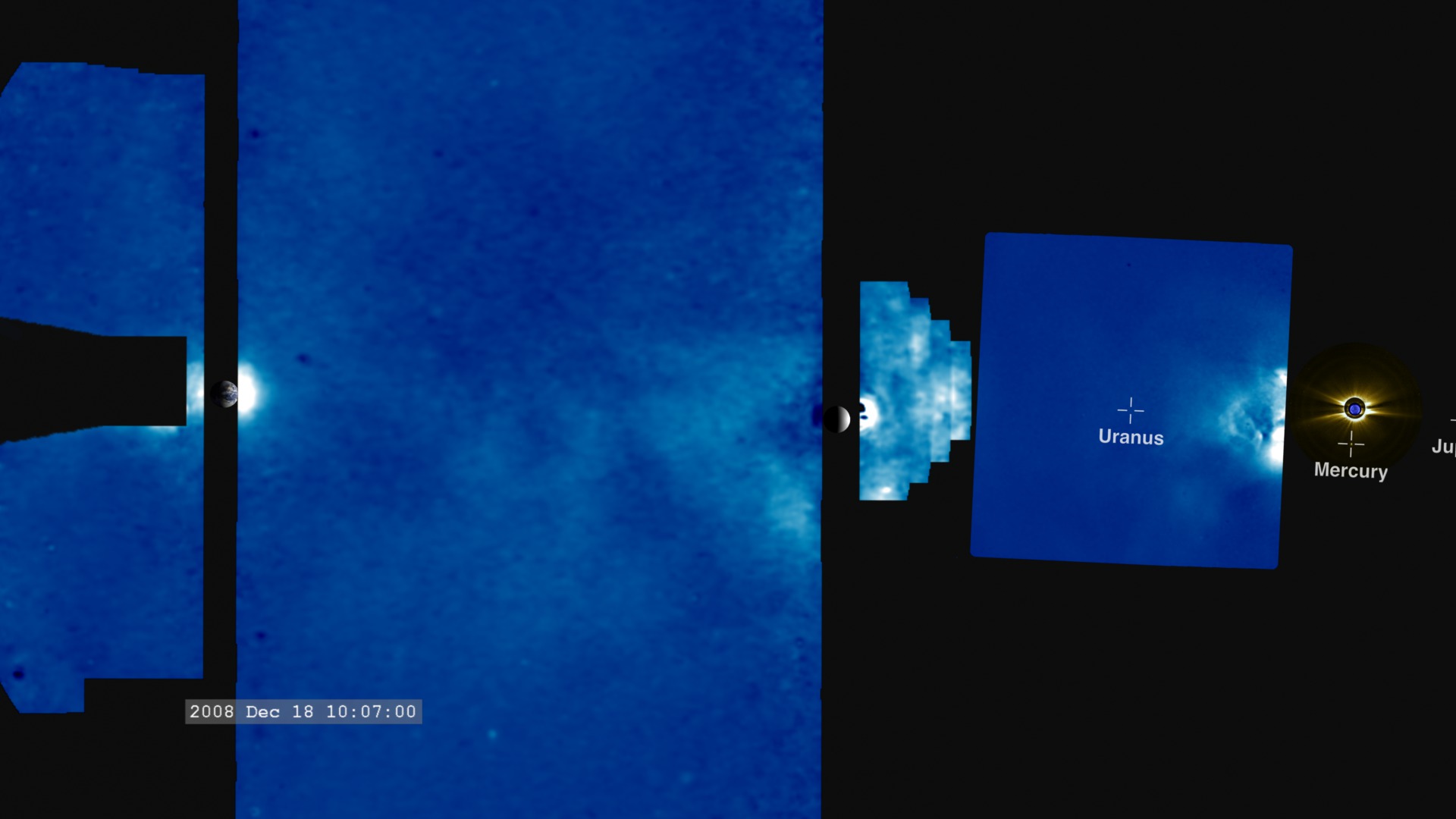From the Sun to the Earth: The View from STEREO-A with no CME Enhancement
This visualization shows the original dataset from STEREO-A used to extract the motion of the coronal mass ejection (CME) in ID 3890. The data are combined from the SECCHI instrument, which includes an ultraviolet image of the Sun (EUVI), two coronographs (COR-1 & COR-2), and the wide-angle Heliospheric Imagers (HI-1 & HI-2).
On this scale, the CME is so faint as to be invisible. However, the Heliospheric Imagers support such a broad range of image intensity that it is possible to observe the CME propagating through the field of view by computing differences of images with the preceeding image. This process is shown in animation #3890.
The Earth (left side) and Venus (middle) are so bright as to 'bloom' along the readout line of the CCD (Charge-coupled device) pixels, which creates the bright vertical lines that move slightly with time. The dark shape on the left of the field of view is created by an occulting tab that was installed to (occasionally) hide the bright Earth in the view.
The little cross markers label three other planets in the view of STEREO. Uranus is almost invisible in the scale of this imagery, but is visible in full-resolution datasets.
A movie of the heliospheric region viewed from STEREO-A. If you watch the bright 'bloom' created by the Earth (left side) starting around the December 28, 2008 time marker, you will see a much smaller, fainter 'bloom' appear between the Earth and the Sun. This is the Moon appearing at maximum elongation relative to the STEREO-A spacecraft.
Credits
Please give credit for this item to:
NASA/Goddard Space Flight Center Scientific Visualization Studio
-
Animator
- Tom Bridgman (Global Science and Technology, Inc.)
-
Producer
- Scott Wiessinger (USRA)
-
Scientist
- Craig DeForest (SwRI)
Release date
This page was originally published on Friday, December 16, 2011.
This page was last updated on Sunday, January 5, 2025 at 10:04 PM EST.
Missions
This page is related to the following missions:Series
This page can be found in the following series:Datasets used
-
[STEREO-A: Extreme UltraViolet Imager (EUVI)]
ID: 185This dataset can be found at: https://stereo.gsfc.nasa.gov
See all pages that use this dataset -
[STEREO-A: Coronograph 1 (COR1)]
ID: 186This dataset can be found at: https://stereo.gsfc.nasa.gov
See all pages that use this dataset -
[STEREO-A: Coronograph 2 (COR2)]
ID: 187This dataset can be found at: https://stereo.gsfc.nasa.gov
See all pages that use this dataset -
[STEREO-A: Heliospheric Imager 1 (HI-1)]
ID: 188This dataset can be found at: https://stereo.gsfc.nasa.gov
See all pages that use this dataset -
[STEREO-A: Heliospheric Imager 2 (HI-2)]
ID: 189This dataset can be found at: https://stereo.gsfc.nasa.gov
See all pages that use this dataset -
171 Angstroms [STEREO: Extreme UltraViolet Imager (EUVI)]
ID: 623This dataset can be found at: https://stereo.gsfc.nasa.gov
See all pages that use this dataset
Note: While we identify the data sets used on this page, we do not store any further details, nor the data sets themselves on our site.
